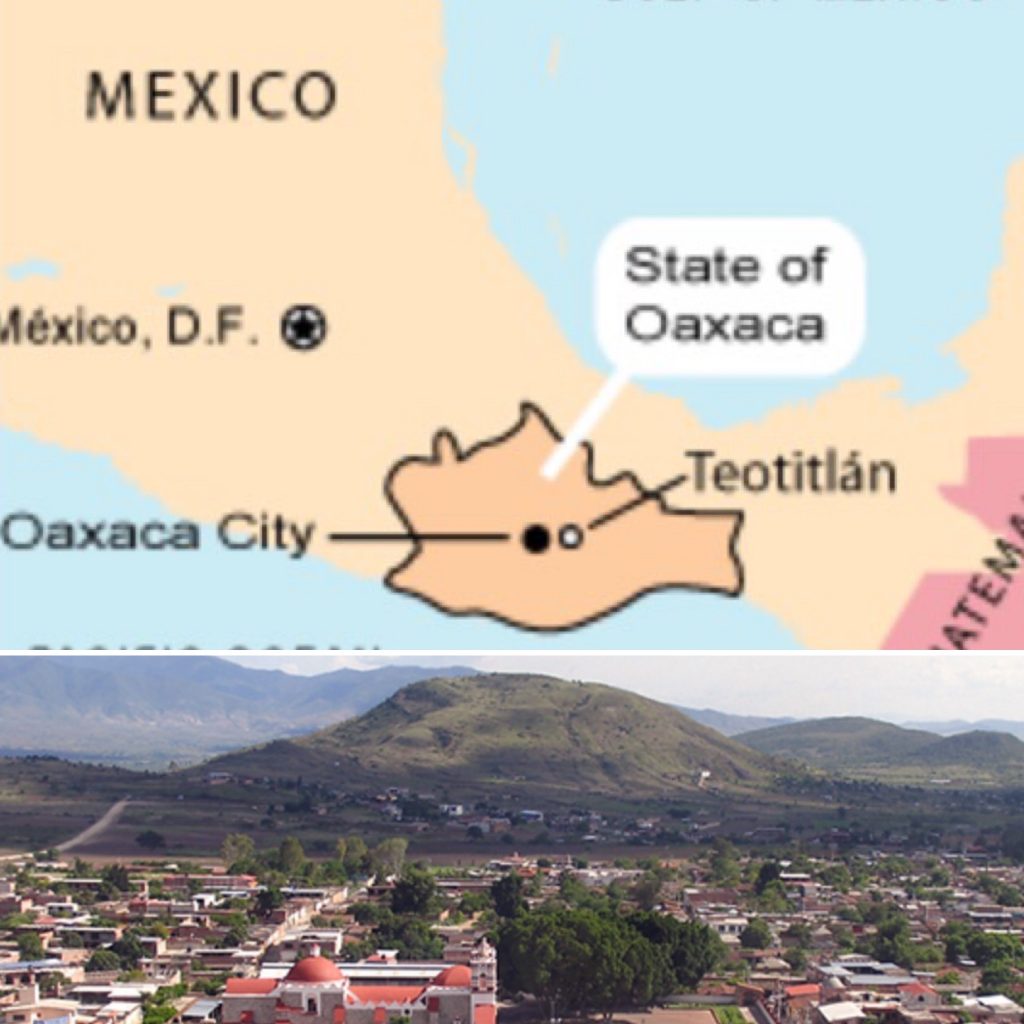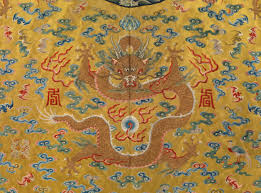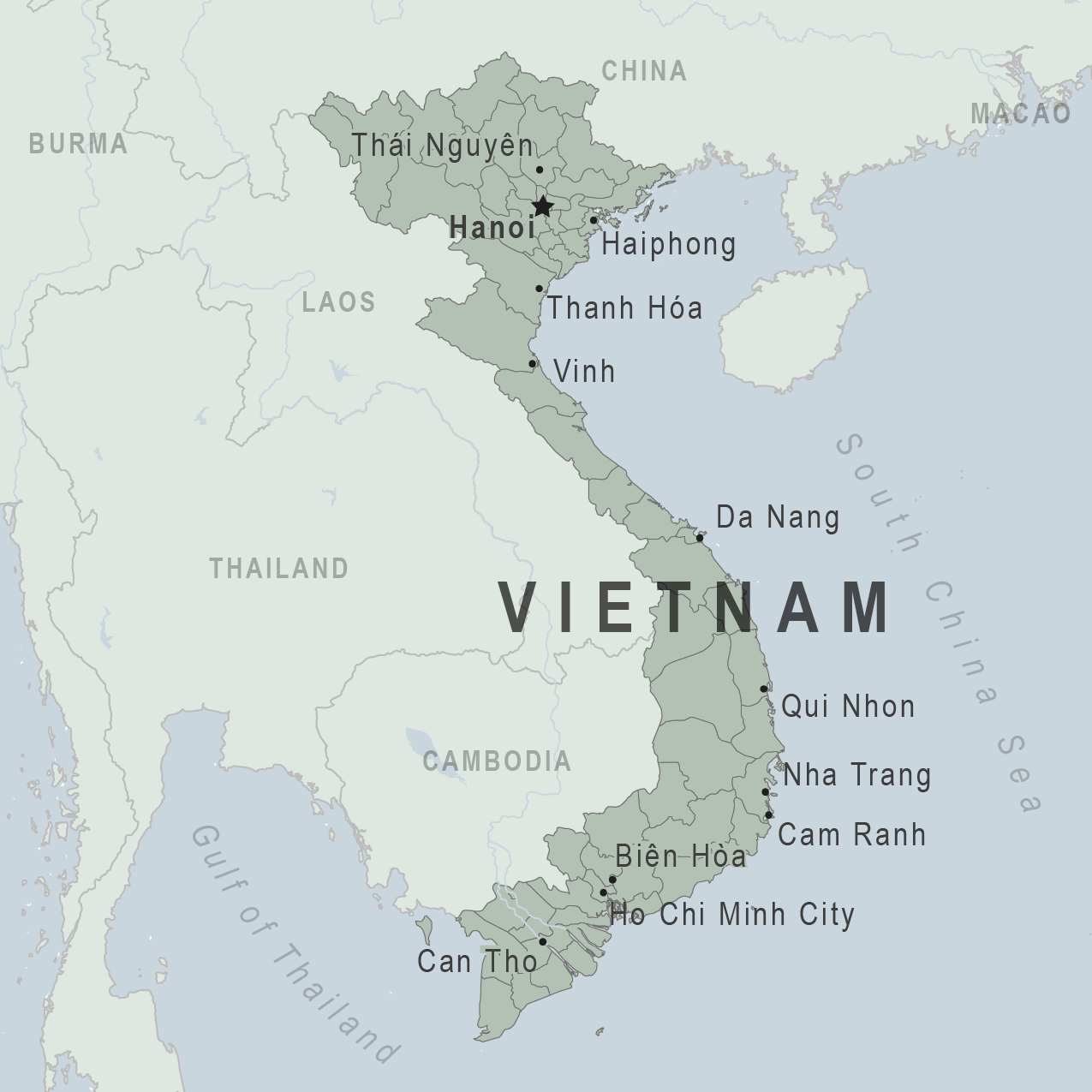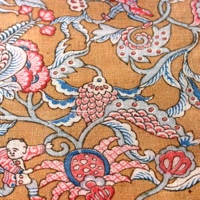
One of the most notable characteristics of Zapotec rugs are the rich colors. The Central Valley is rich in vegetal and animal dyes, and the Spanish brought along salts and oxides that are used as a color toners and fixatives to enrich native natural dyes. With the natural dye workshop coming up, I was drawn to this particular traditional textile. The dyeing process is long and involved, but it’s also cooperative, and the results are stunning.
Among the natural dyes available in Oaxaca, the cochineal is the most renowned. The cochineal is made from an insect that lives and feeds on cacti and produces carminic acid which can be extracted from its body and eggs to make carmine dye.

Other classic natural dyes used to color the wool include: the cempasuchil flower for yellow shades, indigo for blue hues, pecan bark and walnut husks for brown, and huisache pods for black. Natural acids (lemon juice for example) and heat are also strategically used to draw out the desired shade of color for the dyed wool.
Zapotec rug patterns are drawn out beforehand, and traditional patterns feature glyphs, fretwork animals, and idols taken from the archeological remains of the village church. The designs represent Teotitlan’s history and culture, and overtime, they have even come to incorporate Navajo patterns or reflect famous paintings. Zapotec rugs are a statement piece and testimony to family and history.
References:
https://www.mexican-folk-art-guide.com/zapotec-rugs.html#.X4XRPhNKiYU
https://www.monarchandmallard.com/notes-from-the-road/handwoven-rugs-of-oaxaca
]]>
18th Century Dragon Robe, Met Collection 
18th Century Dragon Robe, Met Collection 
18th Century “Summer Gauze” Dragon Robe, Sotheby’s 
18th Century “Summer Gauze” Dragon Robe, Sotheby’s

Tang Dynasty: 618 to 907 AD 
Qing Dynasty: 1644 to 1912

Dragon robes during the Qing Dynasty were used to denote a person’s ranking at court. There were strict edicts dictating how court officials had to dress. These garments ranged in various colors, with bright yellow only being allowed to be worn by the emperor, empress dowager, empress, and first-rank consorts. Golden yellow, orange-yellow, apricot yellow, greenish-yellow, and a brown/plum shade for worn by other nobles of varying ranks. Other colors, such as blue, were made for lower-ranking court nobles.
The robes shown above are from the Qing Dynasty, China’s last great ruling dynasty which lasted until the year of 1912. Although many of the robes we have today only date back to the 18th century, these garments have an extremely long history. Depictions of court officials in them were found as far back as the Tang Dynasty, from 618 to 907 AD. Throughout the years, the dragon robes have gained even further meaning. The pictures shown above express how the detail and opulence of these robes have developed from the Tang Dynasty to the Qing Dynasty, with greater amounts of handwork, trim, and precious items.
Color was not the only way to denote ranking on these garments. The Twelve Symbols of Sovreignty, dated all the way back to the Zhou Dynasty (1050-771B.C.), have long been used on clothing as a symbol of authority. These symbols include: sun, moon, constellation of three stars, mountain, dragon, pheasant, two goblets, seaweed, grain, fire, axe head, fu symbol. When put together, they express the ability of the emperor to lead the country justly with his dignity, virtuosity, and capability. This reason is the why only the emperor is allowed to have all twelve symbols on his robes. Other officials were allowed to use some symbols, but never near the full set of 12.
In addition, dragons were used extensively on this type of garment. Dragons with five claws called “long,” were exclusively for the emperor- while his sons were able to wear dragons with five claws called “mang.” His grandsons and nobles (down to the seventh rank of the court) would wear dragons with four claws, also called “mang.”
The people responsible for making these robes would be imperial court weavers. They typically reside within the palace walls, at a designated working pavillion/hall. Silk was used for two ceremonial robes per year, only for the emperor. The rest of the court robes would be made of satin and gauze. Chief dyers would be responsible for the bright colors of the court, and guarded their recipes fiercely for fear of theft. Some dragon robes were embroidered, while others were woven with the patterns. Pearls and thread made from precious metals were often additions to the robe. Texts from the Ming Dynasty mention dragon robes having to be made on looms up to fifteen feet high, with fabric being made so fine that the knots could not be felt or seen.
What is most special about the tradition of dragon robes is that they’ve survived the changing customs and history of so many of China’s dynasties. From the Tang Dynasty to the Qing Dynasty alone is a span of 1294 years. Throughout those years, the form of the dragon robes, the way they’re made, and who is allowed to wear them has changed but the idea still remains greatly the same.
I chose to research this because while these robes are something I’ve seen a lot in old chinese historical pieces, I’ve never actually looked into their significance. I was always interested in the luxurious hanfu that the noble women of that time wore, while these robes faded into the backdrop for me. It’s interesting how a garment that took so many resources and so much time to produce could so easily fall into the background for me. I think it speaks a lot about the opulence and power of the ancient chinese dynasties.
]]>
In terms of historical context, the Tartans are actually very important pieces of history for Scottish family clans. When someone weaves a plaid print, they are actually not creating an official Tartan unless the pattern is verified by the Scottish clan’s organization and follows the specific rules for that set pattern. For an example, I actually used my family’s history, because I am related to the Wallace family dynasty that became famous in Scotland in the 12th and 13th centuries. Different families have different official Tartans, and some of the Wallace Tartans can be found below. These three patterns were first officialy verified by the family in the 19th century, but similar Tartans existed centuries before as a part of the Gaelic Uallas kingdom, the precursor to the Wallace family.



Official Tartan fabrics were first found in these family dynasties in Scotland in the 16th century. At the time, Scotland’s map was much different than today, but Tartans popped up in various locations around this area.

It was fascinating to go down this rabbit hole of weaving, Tartans, and my family history. It is really powerful to notice and feel how so many different aspects of life are deeply connected in unexpected ways.
Resources:

Historically, the knots were used to record information and convey messages before writing systems were developed. Ancient tools, likely for tying and untying knots, have been discovered and analyzed to have originated a hundred thousand years ago. The earliest known transition to artistic expression of knots was during the Tang Dynasty (618-907 CE) and continued throughout the following generations.

In the modern day, different knots hold different meaning and can be implemented on a variety of occasions.

The pan chang knot is one of the most recognizable and symbolizes the cycle of life. Since it has no visible start or end, it is perceived to mean a smooth, long, happy life and is widely popular during the New Year. The double coin knot, resembling a stack of coins, represents wealth and prosperity which makes it more common in jewelry to “wear” a long, successful life. On the other hand, the button knot is used mainly in place of buttons on traditional clothing and has a meaning of the natural cycles of the universe. Additionally, Chinese knotting is deep red to symbolize good fortune, a common theme throughout Chinese culture.

Moreover, the meaning of the Chinese for word ‘rope’ (shèng) is a homonym to words meaning spirit, divine, and life. So knots also had a spiritual meaning in their use. The word for ‘knot’ (jié) also has other meanings in different contexts. For example, ‘tuán jié’ which means ‘to unite,’ ‘jié hūn’ means ‘to marry,’ and ‘jié guŏ’ means ‘bear fruit,’ ‘result,’ or ‘outcome.’ Therefore, a knot given to a marriage partner or a couple means all these things and to have children as well.
Reference: https://www.chinahighlights.com/travelguide/culture/knot.htm
]]>
The dying process would usually include indigo from leaves that were locally grown or grains that were imported. The leaves are collected and left to ferment. The dying was done in large pots that are sunken into the ground. The cloth was dipped and then given time to oxidize until it turned blue. If a sheen effect was intended it would be beaten with a mallet.
Adire Oniko is a type of Adire traditional dying that uses raffia as resists. There are specific patterns that have names but those names would range from town to town. Other resists were used to create patterns like Adire Alabere (stitch resists), Adire Eleko (starch resists), and the practice of hand painting which used chicken feathers, palm leaves, and match sticks.

Adire production was most popular in Ibadan. There is even a pattern to celebrate the city called, Ibadun dun (“Ibadun is good”.)
I chose this tradition because I’m Yoruba, so seeing the name got me interested because of connection to the tribe. Then looking at the textiles, I realized that the name and methods to get the intended textile were unfamiliar but the cloth itself was not. I’ve seen Adire cloths in closets at home, old family pictures and at parties/gatherings. I got my information from the Victoria and Albert Museum.
]]>.jpg)
Sources: https://koreancentersf.org/merchandise/
“A jogakbo is a style of patchwork, traditionally used to create domestic wrapping cloths (known as bojagi) from scraps of left-over fabrics. The art of making wrapping cloths has enjoyed a long history in Korea. During the Joseon dynasty (1392–1910), women, living in a male-dominated society and excluded from formal education, concentrated on domestic tasks such as weaving and embroidery. They produced costumes, beddings, and wrapping cloths for the whole household. Following the ideas of frugality and simplicity advocated during the dynasty, the left-over fabrics were not discarded, but would be used to create a jogakbo by patching those scraps together into larger squares or rectangles.
A jogakbo is comprised of scraps of one type of fabric, such as cotton, silk or ramie (a plant fibre native to eastern Asia which has a particularly lustrous appearance), hemp or even paper. The scraps are sewn together using a triple-stitched seaming technique known as gekki, which results in a sealed, flat seam and gives the jogakbo their distinctive ‘window pane’ appearance. Patches are joined into squares and extended in an irregular, improvisatory fashion until a cloth reaches the required size. The jogakbo can include several colours composing a modern abstract pattern, or be made of one single-colour…”
Source: Victoria & Albert Museum, London (https://www.vam.ac.uk)
https://daramji.co/2017/03/20/jogakbo/
Jogakbo is Korean traditional patchwork known for its beauty in composition and colour balance – all from leftover bits of fabric. Jogak means piece and bo means wrapping cloth; it’s wrapping cloth made from fabric pieces.
Just like quilting traditions in other cultures, jogakbo was born out of the frugal hands of women who were able to find beauty in just about everything they touched.
Many Koreans reminisce about the times when their mothers and grandmothers would get together for an evening of patchwork which would flow into the small hours of the night with endless chatter about all matters of heart. The fruit of their labour, with their sighs and laughters in every stitch, was then passed down from mothers to daughters like a family heirloom.

“Beauty of ‘jogakbo’ rediscovered” by Kown Mee-yoo
Huh Dong-hwa exhibited his collection at the Museum of Korean Embroidery. He calls jogakbo the equivalent to a family portrait before photography was invented, containing the life of the woman who stitched it- the red and yellow scraps from the dress she wore for her wedding, blue pieces from her husband’s official uniform, and multicolored pieces might come from her children’s clothes.
“I think jogakbo is similar to geometric abstract art by Piet Mondrian or Paul Klee. Bojagi is a part of daily life in Korea and it is difficult for us to discover artistic values in it, but when exhibited overseas, foreigners easily find the aesthetic beauty of jogakbo. Maybe that is why those jogakbo are exhibited among my collection mostly overseas.” -Huh Dong-hwa
https://www.vam.ac.uk/articles/jogakbo-traditional-korean-patchwork


Above is a hanbok, the traditional Korean clothing, with jogakbo style applied to it.
I chose this tradition because I really admire the upcycling of textiles to create new ones, and the beauty of using scraps to make something that is different but still beautiful by hand. You look at it and you know that there is a story behind it, where each piece of fabric came from. As someone who loves to make things by hand, it makes me want to start patching together all of my old clothes, to make textiles like this.
]]>
Smart textiles are often used for aesthetic purposes. These smart textiles are primarily used in the fashion industry and usually light up or change color.

Zendaya at the 2019 Met Gala 
Models at the CuteCricut runway show (models used mobile phones to light up their garments) 
Interactive LED dance shoe by Moritz Waldemeyer
https://www.researchgate.net/figure/Smart-textiles-a-Interactive-Led-dance-shoe-by-Moritz-Waldemeyer-waldemeyer-2011-b_fig10_221913740
Smart textiles can also be used for performance enhancement, focusing on function over fashion. Using technology embedded in the fabrics, these textiles can regulate body temperature, reduce wind and water resistance, guard against radiation, minimize the effects of space travel, and control the vibration of muscles.
https://www.apexmills.com/media_post/smart-textiles/

Komodotec Smart Sleeve (can measure heart rate, track steps, and sleep) 
Astronaut suits are considered smart textiles (can regulate temperature, guard against radiation, etc.) 
Machina MIDI controller jacket (can create music through body movements and sensors)
https://www.machina.cc/products/midi-jacket
Smart textiles is a growing industry. Although few products have been successful in reaching consumers, with the increase of production and improvement of products, it will soon be a useful technology that can improve our health and safety and prove unique visuals and activities that were not possible before. I chose this topic because I am always interested in seeing how technology and art can intersect.
]]>


typical wedding ao dai
The textile tradition that I chose to talk about was the traditional dress in Vietnamese culture. The traditional dress for women was the female version of the ao dai (pronounced like ow-ee-yai) which is typically a silk tunic that flows down to the ankles and white silk trousers or a long skirt underneath, depending on which region of Vietnam. In the past, the color of the ao dai often reflected class and status. For example, those of the upper class often had gold details and royalty often had intricate gold embroidery of dragons.

The origin of ao dais is said to be in Hanoi, the capital of Vietnam, but no one knows when it really sprouted its roots. There has been a lot of evolution of the style of ao dais as is laid out in the video below. The first clear evidence of the ao dai was in the late 1700s, in the North, the northern lords of Hanoi forced subjects to wear ao giao linh (ow-yow-lin), which was essentially a front buttoned gown and skirt. In the South, members were demanded to wear gowns and trousers. Later we saw the northern version begin to evolve into the current image of the ao dai by shifting to differentiate between social classes. In the early/mid 20th century, when French colonization took over in Vietnam, Hanoian artist, Cat Tuong varied the ao dai into many different silhouettes, taking inspiration from Western fashion. Many of the designs were considered too scandalous for traditional Vietnamese culture, so the ao dai evolved to be made of 2 flaps, tight to the body, and closed at the neck. In the late 1950s when the US replaced the French occupying forces, there was a controversial fashion statement made by the wife of the President’s chief advisor that resulted in a ban on the style of ao dai. However, this created even more popularity for the ao dai, especially in Southern Vietnam when Saigon designer Dung Dakao revolutionized the dress again. In the 1980s, ao dais began to be made with lighter materials, vivid colors, patterns of plants, flowers, and geometric shapes. In the 21st century, the ao dai was worn less on a daily basis but remains as a symbol of cultural pride, grace, beauty, and creativity.
In today’s society, ao dai are most commonly seen at Vietnamese weddings, as can be seen in the third image at the top. The bride will traditionally wear red and the groom will wear either blue or red. Guests at the wedding will also wear an ao dai.

The image quality is kind of bad but here is a picture of me at my uncle’s wedding wearing an ao dai :)) I chose to research this topic because my dad’s side of the family is from Vietnam and I have been wanting to get an ao dai custom made for myself so it is very exciting to learn about the history of the ao dai. This is part of my family’s culture and it is important to learn 

Sarasa has its origins in the early Edo Period (1603 to 1868) of Japan when Portuguese seafaring traders introduced cotton calicos or chintz they acquired in India. Imported Indian calicos were exceedingly expensive and too high-priced to be making into kimonos.

Production of domestic sarasa began in the late 1600s when Japanese dye workers found a method to replicate the designs of Indian calicos from their own style and production techniques. Master Japanese textile makers applied their indigenous katazome textile printing skills into making sarasa (rice paste resist dyeing with washi paper stencils “katagami”). In addition to katazome printing, a few dye works employed woodblock stamping to produce sarasa patterns on fabric.

Production of domestic sarasa began in the late 1600s when Japanese dye workers found a method to replicate the designs of Indian calicos from their own style and production techniques. Master Japanese textile makers applied their indigenous katazome textile printing skills into making sarasa (rice paste resist dyeing with washi paper stencils “katagami”). In addition to katazome printing, a few dye works employed woodblock stamping to produce sarasa patterns on fabric. And the dye maker somtimes also hand painted colors on the fabric.
These were characterized by distinctive floral and animal designs with geometric shapes favored by the Japanese. Madder dye derived from the native akaso plant provided Japanese dye masters with the desired red and brown colors favored for producing sarasa prints. The hitherto dominate Japanese indigo blue played a minor role in sarasa colors.
source: https://www.kimonoboy.com/sarasa.html
]]>





















